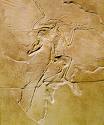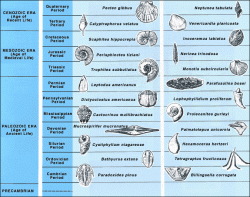Fossils
A fossil is the preserved remains of animals, plants, and living things that lived a long time ago. Fossiliferous means an object contains or has fossils inside. The study of fossils is the science of paleontology. Fossils can be microscopic in size or the size of a dinosaur. Fossils normally preserve animals and plants.
The difference between body fossils, trace fossils and chemofossils is body fossils are the fossils of a body. Chemofossils are chemical processes in fossilized organisms and trace fossils are footprints.
Lagerstatten are fossils with good preservation that sometimes preserved soft tissues. The oldest fossils are stromatolites of layers of rock. The first stromatolites found were blue-green algae. We didn’t always know what fossils were. Chinese people thought bones of ancient mammals were “dragon bones” and used them for medicine.
Fossils are dated by using radiometric and carbon 14. Radiometric and carbon 14 are techniques used to date materials.
A fossil forms when a skeleton is preserved in rock over millions of years. Permineralization occurs when a skeleton is covered by dirt and rocks, the empty spaces inside an object fill with groundwater, filling the spaces. When a shell, bone or tissue gets replaced with another mineral it is called replacement. When skeletal remains get replaced by crystals it is called recrystalization.
A cast is a hole (made from the remains of something) that gets filled up with minerals. Compression fossils are the result of chemical reduction of the molecules that make up the tissues. Biommuturation is when one skeleton overgrows another skeleton and preserves it. Trace fossils are footprints, burrows, erosion, eggs, nests, and droppings. Microfossils are fossils just barely seen or smaller.
A fossil is the preserved remains of animals, plants, and living things that lived a long time ago. Fossiliferous means an object contains or has fossils inside. The study of fossils is the science of paleontology. Fossils can be microscopic in size or the size of a dinosaur. Fossils normally preserve animals and plants.
The difference between body fossils, trace fossils and chemofossils is body fossils are the fossils of a body. Chemofossils are chemical processes in fossilized organisms and trace fossils are footprints.
Lagerstatten are fossils with good preservation that sometimes preserved soft tissues. The oldest fossils are stromatolites of layers of rock. The first stromatolites found were blue-green algae. We didn’t always know what fossils were. Chinese people thought bones of ancient mammals were “dragon bones” and used them for medicine.
Fossils are dated by using radiometric and carbon 14. Radiometric and carbon 14 are techniques used to date materials.
A fossil forms when a skeleton is preserved in rock over millions of years. Permineralization occurs when a skeleton is covered by dirt and rocks, the empty spaces inside an object fill with groundwater, filling the spaces. When a shell, bone or tissue gets replaced with another mineral it is called replacement. When skeletal remains get replaced by crystals it is called recrystalization.
A cast is a hole (made from the remains of something) that gets filled up with minerals. Compression fossils are the result of chemical reduction of the molecules that make up the tissues. Biommuturation is when one skeleton overgrows another skeleton and preserves it. Trace fossils are footprints, burrows, erosion, eggs, nests, and droppings. Microfossils are fossils just barely seen or smaller.
The difference between body fossils, trace fossils and chemofossils is body fossils are the fossils of a body. Chemofossils are chemical processes in fossilized organisms and trace fossils are footprints.
Lagerstatten are fossils with good preservation that sometimes preserved soft tissues. The oldest fossils are stromatolites of layers of rock. The first stromatolites found were blue-green algae. We didn’t always know what fossils were. Chinese people thought bones of ancient mammals were “dragon bones” and used them for medicine.
Fossils are dated by using radiometric and carbon 14. Radiometric and carbon 14 are techniques used to date materials.
A fossil forms when a skeleton is preserved in rock over millions of years. Permineralization occurs when a skeleton is covered by dirt and rocks, the empty spaces inside an object fill with groundwater, filling the spaces. When a shell, bone or tissue gets replaced with another mineral it is called replacement. When skeletal remains get replaced by crystals it is called recrystalization.
A cast is a hole (made from the remains of something) that gets filled up with minerals. Compression fossils are the result of chemical reduction of the molecules that make up the tissues. Biommuturation is when one skeleton overgrows another skeleton and preserves it. Trace fossils are footprints, burrows, erosion, eggs, nests, and droppings. Microfossils are fossils just barely seen or smaller.
A fossil is the preserved remains of animals, plants, and living things that lived a long time ago. Fossiliferous means an object contains or has fossils inside. The study of fossils is the science of paleontology. Fossils can be microscopic in size or the size of a dinosaur. Fossils normally preserve animals and plants.
The difference between body fossils, trace fossils and chemofossils is body fossils are the fossils of a body. Chemofossils are chemical processes in fossilized organisms and trace fossils are footprints.
Lagerstatten are fossils with good preservation that sometimes preserved soft tissues. The oldest fossils are stromatolites of layers of rock. The first stromatolites found were blue-green algae. We didn’t always know what fossils were. Chinese people thought bones of ancient mammals were “dragon bones” and used them for medicine.
Fossils are dated by using radiometric and carbon 14. Radiometric and carbon 14 are techniques used to date materials.
A fossil forms when a skeleton is preserved in rock over millions of years. Permineralization occurs when a skeleton is covered by dirt and rocks, the empty spaces inside an object fill with groundwater, filling the spaces. When a shell, bone or tissue gets replaced with another mineral it is called replacement. When skeletal remains get replaced by crystals it is called recrystalization.
A cast is a hole (made from the remains of something) that gets filled up with minerals. Compression fossils are the result of chemical reduction of the molecules that make up the tissues. Biommuturation is when one skeleton overgrows another skeleton and preserves it. Trace fossils are footprints, burrows, erosion, eggs, nests, and droppings. Microfossils are fossils just barely seen or smaller.


